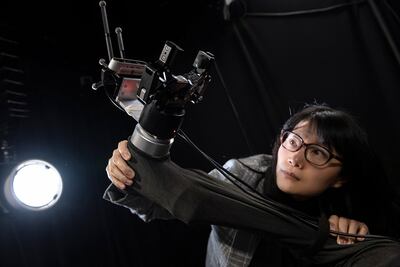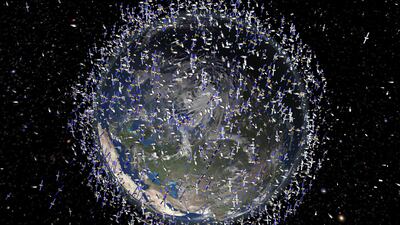This is the ultimate challenge in waste collection: plucking from space a broken satellite travelling at 25,000kph, operating in levels of radiation that can frazzle powerful on-board computers.
From nets and harpoons to magnets, scientists are working on potential solutions to the rapidly growing problem of space junk that threatens planned new mega-constellations of low-cost satellites orbiting Earth.
More than a million pieces of debris larger than a centimetre are estimated to be in orbit after more than 630 break-ups, explosions and collisions involving man-made satellites, according to analysis from the European Space Agency (ESA).
The space industry is responding to the problem with a new model of sustainable space operations in which the industry will clear up its own mess and develop tools to refuel and repair satellites to extend their use.
A new fleet of space service vehicles with a range of tools, likened to a Swiss Army knife, is planned to refurbish existing satellites. Dedicated craft will try to snag debris to protect the 5,000 operational satellites currently in orbit.
About 300 missions are expected to service satellites and remove debris by 2030, Yang Gao, professor of space autonomous systems at the University of Surrey, a leading centre of technological research in England, tells The National.

She is running a project to tackle one element of the problem at the UK’s Surrey Space Centre, where they are testing a robotic arm that uses artificial intelligence to view and grab spinning pieces of junk.
The system, which has the potential to carry out repair work too, is aimed at attracting a new generation of cost-cutting private operators because it has the potential to work autonomously in space without a human controller.
Let there be light
The robotic arm fires light at the defunct satellite and uses its on-board computer to work out the best point at which to grab the tumbling piece of junk. The extreme lighting conditions in space pose significant technical difficulties, the project developers say.
“It's almost like when people go to a desert, they tend to lose themselves because of a lost sense of orientation – there's no reference point,” Prof Gao says.
Damaging levels of radiation and the need for high levels of protection also impose limits on the capacity of on-board computers. “Because of that, we cannot run very complex algorithms on the spacecraft in real time,” she tells The National.
“That's why we have to be so creative with the way we use artificial intelligence. You can’t just deploy any AI you use on Earth, we need to do a lot of designs specifically for these challenges.”
The work done at Surrey University is considered a key pillar of the UK's role as a leading member of the ESA, the continental equivalent of Nasa. Space has taken additional importance in the wake of the Brexit decision for the UK to leave the EU but maintain some strategic co-operation with its former European partners.
"ESA membership, however, continues to provide the UK with a route to participate in civil international space missions and exploration, and a way for its domestic space industry to contribute and win business," a note from the International Institute of Strategic Studies concluded last October. "UK industry and academia are involved in ESA projects including a lunar satellite system, Mars exploration missions, projects to address space debris and Earth observation satellites."

The robotic arm is scheduled to be ready for use by 2025, when the first mission to remove an ESA-owned rocket part is expected to launch. The ClearSpace-1 mission will use a different form of technology, a grabber likened to Pac-Man, after the popular 1980s arcade game.
The mission is “fundamental to demonstrate worldwide that we can remove debris”, said Luisa Innocenti, who is head of the Clean Space office at ESA.
Grabbing systems are only one solution being developed by those trying to clear up space.
Other techniques being assessed or developed include a system of spinning magnets – promoted by a team from the University of Utah – to gently manoeuvre space scrap into an orbit where it eventually burns up.
Japanese satellite servicing company Astroscale launched a mission, ELSA-d, with two spacecraft in March last year to demonstrate how a magnet could be used to capture space junk.
The company, which describes itself as a breakdown service in space, successfully completed the first stages of its test that involved unlocking two linked craft, then recapturing the smaller 17 kilogram replica debris unit.
But more complex elements of the programme, including tracing and capturing a tumbling piece of junk, have been suspended because of what Astroscale said were “anomalous spacecraft conditions”.
“Our mission to prove the technology for capturing orbital debris in space continues,” the company said in February. “The safety of ELSA-d, and of the orbital environment, remains our top priority. Both spacecraft are under control and being continually monitored.”
A harpoon was successfully tested 400 kilometres above Earth in 2019. The harpoon pierced the centre of a tethered aluminium target in a test that researchers hoped would clear the way for specialist "space tugboats" to snag malfunctioning craft and drag them towards Earth until they burn up on re-entry.
But the harpoon carries a risk of creating more space junk, Prof Gao says. “We definitely want something more like a robotic arm because that's more controllable … only then you can say this space debris is removed rather than you’re creating new ones.”
The dangers from space debris were highlighted in 2009 when two satellites collided for the first time, about 800 kilometres above Siberia.
The operational US satellite and the out-of-service Russian craft created about 2,000 pieces of junk that scientists say will remain in orbit for decades.
The incident stoked concerns first mooted by a Nasa scientist in the 1970s that the amount of junk in orbit would reach a point where repeated collisions make it impossible for satellites to orbit safely.
A conference held by the Royal United Services Institute think tank in 2019 noted that the Kessler Effect – in which two objects colliding would cause potentially infinite other collisions – posed the same threat to the use of space as climate change or plastics in the oceans pose on Earth.
"The cleaning of orbits through debris removal is currently very expensive and still in trial phase and will require international co-operation," the conference report said. "Prevaricating may mean passing a point beyond which any intervention will have a negligible impact."


